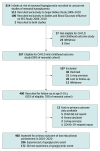Association of Neonatal Hypoglycemia With Academic Performance in Mid-Childhood
- PMID: 35315886
- PMCID: PMC8941348
- DOI: 10.1001/jama.2022.0992
Association of Neonatal Hypoglycemia With Academic Performance in Mid-Childhood
Abstract
Importance: Neonatal hypoglycemia is associated with increased risk of poor executive and visual-motor function, but implications for later learning are uncertain.
Objective: To test the hypothesis that neonatal hypoglycemia is associated with educational performance at age 9 to 10 years.
Design, setting, and participants: Prospective cohort study of moderate to late preterm and term infants born at risk of hypoglycemia. Blood and masked interstitial sensor glucose concentrations were measured for up to 7 days. Infants with hypoglycemic episodes (blood glucose concentration <47 mg/dL [2.6 mmol/L]) were treated to maintain a blood glucose concentration of at least 47 mg/dL. Six hundred fourteen infants were recruited at Waikato Hospital, Hamilton, New Zealand, in 2006-2010; 480 were assessed at age 9 to 10 years in 2016-2020.
Exposures: Hypoglycemia was defined as at least 1 hypoglycemic event, representing the sum of nonconcurrent hypoglycemic and interstitial episodes (sensor glucose concentration <47 mg/dL for ≥10 minutes) more than 20 minutes apart.
Main outcomes and measures: The primary outcome was low educational achievement, defined as performing below or well below the normative curriculum level in standardized tests of reading comprehension or mathematics. There were 47 secondary outcomes related to executive function, visual-motor function, psychosocial adaptation, and general health.
Results: Of 587 eligible children (230 [48%] female), 480 (82%) were assessed at a mean age of 9.4 (SD, 0.3) years. Children who were and were not exposed to neonatal hypoglycemia did not significantly differ on rates of low educational achievement (138/304 [47%] vs 82/176 [48%], respectively; adjusted risk difference, -2% [95% CI, -11% to 8%]; adjusted relative risk, 0.95 [95% CI, 0.78-1.15]). Children who were exposed to neonatal hypoglycemia, compared with those not exposed, were significantly less likely to be rated by teachers as being below or well below the curriculum level for reading (68/281 [24%] vs 49/157 [31%], respectively; adjusted risk difference, -9% [95% CI, -17% to -1%]; adjusted relative risk, 0.72 [95% CI, 0.53-0.99; P = .04]). Groups were not significantly different for other secondary end points.
Conclusions and relevance: Among participants at risk of neonatal hypoglycemia who were screened and treated if needed, exposure to neonatal hypoglycemia compared with no such exposure was not significantly associated with lower educational achievement in mid-childhood.
Conflict of interest statement
Figures
Comment in
-
Hypoglycemia in the Newborn and Neurodevelopmental Outcomes in Childhood.JAMA. 2022 Mar 22;327(12):1135-1137. doi: 10.1001/jama.2022.2456. JAMA. 2022. PMID: 35315906 No abstract available.
References
MeSH terms
LinkOut - more resources
Full Text Sources
Medical


